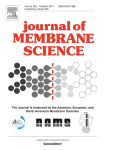 Authors: Álvaro A. RAMIREZ-SANTOS, Christophe CASTEL, Eric FAVRE
Authors: Álvaro A. RAMIREZ-SANTOS, Christophe CASTEL, Eric FAVRE
Affiliation: LRGP-CNRS, Université de Lorraine, 1 Rue Grandville, 54001 Nancy, France
Reference: Ramírez-Santos, Á. A, Castel, C., & Favre, E. (2017). Utilization of blast furnace flue gas: Opportunities and challenges for polymeric membrane gas separation processes. Journal of membrane science, 526, 191-204.
Abstract: “New programs seeking to improve energy efficiency and reduce GHG emissions from the steelmaking industry are studying alternative uses for blast furnace gas such as the VALORCO project in France. One promising alternative is CO2 and CO utilization in which emissions are used for the production of valuable products, like industrial intermediates and fuels synthetized from CO or CO2 or both….”
DOI: 10.1016/j.memsci.2016.12.033
Comments: the authors, within an organization which is an Associate Member of CO-LaN, are using a membrane model within Aspen Plus 8.6 in order to conduct their study. As noted in section 2.3.1 which addresses process calculations,the calculation procedure described” is part of a proprietary gas permeation calculation tool developed in our research group in previous years as a stand-alone Fortran executable. This tool was imported to the Aspen environment by means of the CAPE-OPEN standard, which allows the treatment of the membrane module model as a unit operation block within the process flowsheet and so the connection of material streams in and out of the module.”. This provides an additional example of the transformation of a stand-alone FORTRAN code into a CAPE-OPEN Unit Operation (another known example is one with TUWAX at University of Tulsa). It shows also once more the possibility CAPE-OPEN is giving to research organizations: easy leverage of their results by making use of them in industrial process simulators to conduct industry relevant studies.
